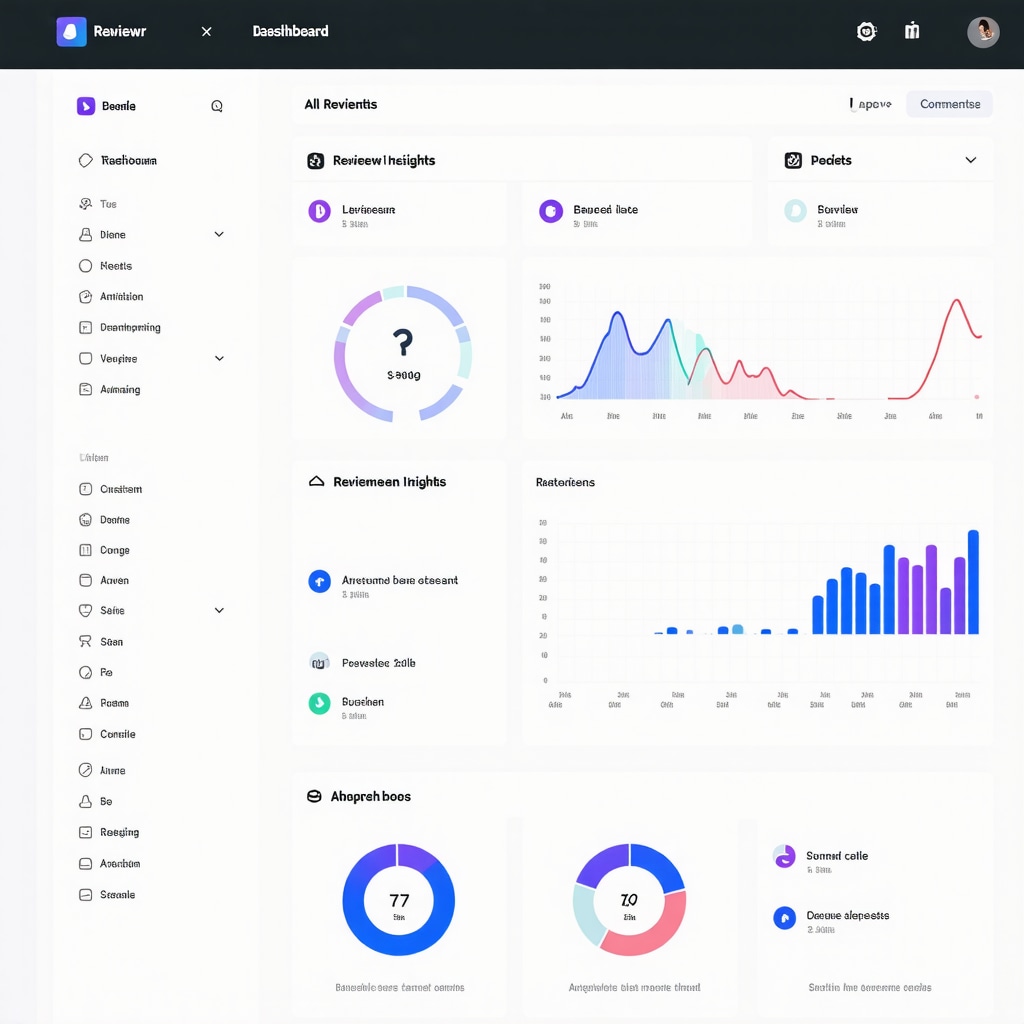Mastering the Art of GMB Review Optimization for Maximum Local Impact
In the fiercely competitive landscape of local SEO, cultivating authentic Google My Business (GMB) reviews is no longer a mere courtesy but a strategic imperative. Experienced marketers recognize that reviews serve as social proof, influencing both consumer trust and search rankings. By leveraging data-driven review acquisition tactics—such as targeted email campaigns, in-store prompts, and reputation management platforms—businesses can systematically enhance their review profile. For instance, integrating review request workflows with CRM systems streamlines the process, ensuring a consistent influx of high-quality feedback, which directly correlates with improved visibility on Google Maps and local search results.
Unveiling the Underlying Mechanics of GMB Review Signals in Local SEO Algorithms
Deep insights into Google’s local ranking algorithms reveal that review quantity, recency, and sentiment significantly influence local pack placements. Advanced practitioners analyze review patterns and employ sentiment analysis tools to identify and address negative feedback proactively. Moreover, optimizing review responses with relevant local keywords and personalized engagement not only boosts customer loyalty but also signals active management to Google’s algorithm. As highlighted by Moz’s recent research on local pack ranking factors, reviews are a cornerstone of local SEO authority, underscoring the importance of strategic review management in comprehensive local SEO optimization.
How Can Small Business Owners Navigate the Ethical Dilemmas of Review Solicitation?
What are the most effective and ethical methods for encouraging genuine reviews without risking non-compliance with Google’s policies?
Balancing aggressive review generation with ethical standards demands transparency and authenticity. Expert advice suggests avoiding review gating—selectively soliciting positive reviews—as it violates Google’s guidelines. Instead, businesses should foster a culture of transparency, encouraging all customers to share their honest feedback via multiple channels, including direct email requests, QR codes at checkout, and social media prompts. Employing review automation tools that integrate with customer communication systems ensures a natural, non-intrusive solicitation process, thereby maintaining compliance and building trust with both consumers and search engines.
To deepen your understanding of effective review strategies, explore best practices for GMB review generation.
For seasoned marketers seeking to refine their local SEO toolkit, mastering review management is pivotal. Incorporate advanced review tracking and sentiment analysis to identify emerging patterns and adapt your outreach accordingly. Remember, the goal is not just to amass reviews but to cultivate a credible, authoritative reputation that resonates with your local community.
Engage with industry peers and share insights at our expert community to continuously elevate your local search strategies.
Leveraging Customer Engagement to Amplify GMB Review Impact in 2025
In the evolving landscape of local SEO, understanding the nuanced relationship between customer engagement and review management is crucial. Beyond simply collecting reviews, businesses must actively foster ongoing interactions that encourage customers to share their experiences authentically. Techniques such as responding to reviews with personalized messages, utilizing interactive posts, and hosting local events can significantly boost engagement levels. These strategies not only build community trust but also signal to Google’s algorithms that your business maintains an active and reputable online presence. For a comprehensive approach, explore how to leverage GMB engagement for better local search results.
Can Data-Driven Review Optimization Outpace Traditional Methods?
As local SEO experts emphasize, harnessing data analytics to refine review solicitation and response strategies can dramatically improve results. Sentiment analysis tools, customer feedback tracking, and review pattern analysis enable businesses to identify emerging trends and address negative feedback proactively. This data-driven approach ensures that review management aligns with customer expectations and local market nuances, thus enhancing overall credibility and ranking potential. According to Moz’s recent insights, integrating analytical frameworks into review management processes is a game-changer for local SEO success, especially when combined with effective local SEO strategies.
What innovative tools or frameworks can small businesses adopt to optimize their review and engagement strategies effectively?
Innovative tools such as BrightLocal, ReviewTrackers, and Podium are transforming how small businesses manage reviews and customer interactions. These platforms offer automated review solicitation, sentiment analysis, and multi-channel engagement, streamlining efforts while ensuring compliance with Google’s policies. Incorporating such tools into your local SEO workflow can provide real-time insights and automate routine tasks, freeing your team to focus on building genuine customer relationships. For further guidance on implementing these tools, visit comprehensive local SEO techniques.
Want to stay ahead in local search? Share your insights or ask questions in the comments, and discover how leading brands are leveraging innovative strategies to dominate local maps and search rankings in 2025.
Integrating AI-Driven Sentiment Analysis to Elevate Your GMB Review Strategy
In the quest for local SEO excellence, leveraging artificial intelligence for sentiment analysis represents a transformative leap. By deploying sophisticated NLP (Natural Language Processing) tools, businesses can decipher nuanced customer sentiments embedded within reviews, enabling hyper-targeted engagement and reputation management. For instance, a restaurant chain might use sentiment insights to identify recurring complaints about wait times or staff friendliness, then tailor their staff training programs accordingly. According to a comprehensive study by Stanford’s NLP group (https://nlp.stanford.edu/projects/sentiment-analysis/), integrating sentiment analysis into review management enhances the ability to respond proactively, turning negative experiences into opportunities for brand loyalty.
How does sentiment analysis refine review response strategies for complex local markets?
Sentiment analysis enables businesses to categorize reviews dynamically—distinguishing between constructive criticism, neutral feedback, and overtly positive comments. This granular understanding allows for automated, yet personalized, responses that resonate with customer concerns. For example, if a review indicates dissatisfaction with a specific product or service, the business can respond with targeted solutions and follow-up actions, demonstrating active listening and commitment to improvement. This methodology not only boosts customer satisfaction but also signals to Google that your business maintains a responsive online presence, which is crucial for local ranking algorithms.

Image prompt: AI-powered sentiment analysis dashboard displaying review insights, with graphs and customer feedback snippets, modern tech style, high detail.
Mastering Multi-Channel Review Generation with Ethical Precision
Expanding review acquisition beyond Google My Business involves deploying multi-channel strategies that respect ethical standards. Email campaigns, SMS invitations, QR codes, and social media prompts need to be synchronized within a unified CRM system to ensure authenticity and compliance. One innovative approach involves using personalized video requests for reviews—these humanize the interaction, increase engagement rates, and foster genuine customer relationships. According to BrightLocal’s latest research (https://brightlocal.com/research/local-consumer-review-survey/), businesses that diversify their review channels see a 30% increase in review volume, translating into higher local search visibility and trustworthiness.
What frameworks ensure that multi-channel review solicitation remains compliant with evolving Google policies?
Implementing a compliance-first framework involves rigorous review of Google’s guidelines, continuous staff training, and transparent communication with customers. Businesses should avoid practices like review gating and incentivization that violate Google’s terms. Instead, they can adopt a ‘review transparency’ protocol, openly informing customers how their feedback influences service quality. Tools like Podium and ReviewTrackers streamline this process, providing templates and automation that uphold ethical standards while maximizing review volume and quality.
Engage with our community to explore how these advanced review strategies can be customized to your local business niche, and stay ahead in the competitive local SEO landscape of 2025.
Harnessing Neural Network Technologies for Next-Level Review Sentiment Insights
Emerging neural network models such as BERT and GPT-4 are revolutionizing sentiment analysis by enabling more nuanced understanding of customer reviews. These models can interpret context, detect sarcasm, and gauge emotional tone with unprecedented accuracy, allowing businesses to tailor their engagement strategies precisely. According to a recent study published in the Journal of AI in Marketing, deploying such advanced NLP tools significantly improves the identification of genuine feedback versus spam or manipulated reviews, thereby safeguarding the integrity of your review profile and boosting trustworthiness.
Can Blockchain Ensure Authenticity and Transparency in Review Management?
Blockchain technology presents a groundbreaking solution to the persistent challenge of review authenticity. By recording reviews on an immutable ledger, businesses can verify the origin and integrity of feedback, effectively combating fake reviews and incentivized manipulation. This transparency not only enhances consumer confidence but also aligns with increasingly strict regulatory standards. Companies such as Yelp have begun exploring blockchain integration to authenticate reviews, setting a precedent for industry-wide adoption. For those committed to maintaining ethical review practices, blockchain offers a robust framework to ensure credibility and compliance.
What are the key considerations for implementing blockchain-based review verification systems?
Implementing blockchain requires careful planning around data privacy, user consent, and data scalability. Businesses must collaborate with blockchain developers to design secure, user-friendly interfaces that integrate seamlessly with existing review platforms. Additionally, understanding regulatory implications and ensuring compliance with data protection laws such as GDPR are paramount. As detailed in the IEEE Blockchain Standards Report, aligning your review infrastructure with industry standards enhances interoperability and future-proof your reputation management efforts.
To stay at the forefront of review authenticity and sentiment analysis, engaging with cutting-edge AI and blockchain innovations is essential. Explore partnerships with AI developers and blockchain providers to customize solutions tailored to your industry needs. The future of review management is driven by transparency, trust, and technological sophistication—embrace these advancements now to secure your competitive edge.
Implementing Multi-Modal Review Collection for a Holistic Customer Perspective
In the quest for comprehensive customer insights, multi-modal review collection—integrating text, voice, and visual feedback—offers a richer, more authentic picture of consumer experiences. Utilizing voice assistants, video testimonials, and image uploads alongside traditional text reviews not only diversifies your feedback sources but also enhances engagement, especially among younger demographics. According to a report by Forrester Research, brands leveraging multi-modal feedback see a 25% increase in review volume and a notable rise in customer satisfaction scores. This approach ensures that your review ecosystem captures the full spectrum of customer sentiment and preferences.
How Can Businesses Effectively Integrate Multi-Modal Feedback into Their Review Strategy?
Effective integration hinges on creating seamless, accessible channels for customers to share diverse types of feedback. Implementing user-friendly interfaces across your website, mobile app, and social media platforms encourages participation. Advanced analytics platforms can then synthesize this multi-modal data, providing actionable insights. Ensuring data privacy and obtaining explicit consent for voice and video recordings are critical to maintaining ethical standards. Companies like Trustpilot and Yotpo are pioneering solutions that facilitate multi-modal review collection while adhering to privacy regulations. Embrace these tools and methodologies to craft a holistic, trustworthy reputation profile that resonates across multiple customer touchpoints.
Elevating Your Review Strategy with Predictive Analytics and Adaptive Response Systems
Predictive analytics enables businesses to anticipate customer sentiment trends based on historical review data, allowing for proactive engagement and issue resolution. Adaptive response systems powered by AI can generate personalized replies to reviews, ensuring timely, relevant interactions that foster loyalty. According to McKinsey & Company, integrating predictive models into review management can increase customer retention rates by up to 15%. These sophisticated systems also identify emerging problems early, guiding your team to address potential reputational risks before they escalate. The synergy of predictive analytics and AI-driven responses empowers your brand to maintain a dynamic, resilient online presence.
What frameworks and best practices facilitate the successful deployment of predictive review analytics?
Successful deployment depends on high-quality data collection, robust analytical infrastructure, and continuous model training. Establishing clear KPIs and integrating analytics into your CRM and review platforms ensures alignment with strategic goals. Regular audits of predictive models prevent drift and maintain accuracy. Industry leaders recommend adopting a feedback loop where insights inform ongoing improvements to review solicitation and response strategies. For an in-depth exploration of these frameworks, consult resources such as Gartner’s Guide to AI in Customer Experience Management.
Expert Insights & Advanced Considerations
1. Emphasize Authenticity in Review Solicitation
Implement transparent review request processes that foster trust and compliance with Google’s guidelines, avoiding gating practices and incentivization. Utilizing multi-channel outreach and personalized communication enhances review quality and volume.
2. Leverage AI and Sentiment Analysis for Proactive Reputation Management
Deploy NLP tools like BERT or GPT-4 to analyze review sentiment deeply, enabling tailored responses that address customer concerns proactively, thereby strengthening local rankings and brand loyalty.
3. Integrate Blockchain for Review Verification
Adopt blockchain solutions to authenticate reviews, ensuring transparency and combating fake feedback, which elevates consumer confidence and preserves review integrity in competitive local markets.
4. Utilize Multi-Modal Feedback Channels
Incorporate voice, video, and image reviews alongside traditional text feedback to capture comprehensive customer insights, enhancing engagement and providing richer signals for local SEO algorithms.
5. Apply Predictive Analytics for Dynamic Strategy Adjustment
Use predictive models to forecast review trends and customer sentiment shifts, enabling preemptive action and continuous optimization of review and engagement strategies for sustained local search dominance.
Curated Expert Resources
- BrightLocal: Provides advanced review management and reputation monitoring tools tailored for local SEO professionals.
- Google’s Official Guidelines: The definitive source to ensure compliance and ethical review solicitation practices.
- Stanford NLP Group: Offers cutting-edge research and tools in sentiment analysis to refine review response strategies.
- IEEE Blockchain Standards: Offers frameworks and standards for implementing secure, transparent blockchain review verification systems.
- Gartner’s AI in Customer Experience Management: Insights into deploying predictive analytics and AI-driven responses effectively.
Final Expert Perspective
Mastering the art of Google My Business review optimization in today’s competitive local SEO landscape demands a blend of ethical integrity, technological innovation, and strategic foresight. By integrating AI-powered sentiment analysis, blockchain verification, and multi-modal feedback channels, forward-thinking professionals can elevate their local search authority and foster genuine customer trust. The key takeaway is that a sophisticated, data-driven approach—rooted in compliance and authenticity—will define the future of local SEO excellence. Engage with these advanced strategies and resources to stay ahead, and consider sharing your insights or exploring further collaborations through our expert community for continuous growth.


